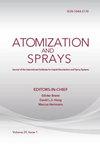Experimental Study on Flash Boiling Spray of High Pressure Liquid Ammonia Jet with Round and Elliptical Hole Nozzles
IF 0.9
4区 工程技术
Q4 ENGINEERING, CHEMICAL
引用次数: 0
Abstract
Ammonia is an ideal alternative fuel for mitigating carbon emissions. High-pressure direct injection of liquid ammonia (LNH3) offers significant advantages in enhancing energy efficiency and minimizing emissions. Due to the high saturation vapor pressure, the injection of LNH3 is susceptible to flash boiling. This study established a high-pressure common-rail LNH3 jet experimental platform and investigated the flash boiling spray characteristics of round and elliptical hole nozzles, by using the high-speed micro-imaging technology with backlight lighting. The results demonstrate that under non-flash boiling conditions, the residual LNH3 in the SAC chamber and nozzle can rapidly corrode the acrylic material of the nozzle, leading to deformation and failure of the nozzle structure. Under flash boiling conditions, LNH3 ejected from the hole will produce spherical macroscopic spray morphology. Then the spray gradually transitions from an elliptical profile to a conical profile as back pressure increases. Compared with round hole nozzles, elliptical hole nozzles exhibit higher flow velocity which enhances oil-gas mixing and promotes more pronounced flash boiling phenomena. Flash boiling occurs at an earlier stage with increased spray cone angle thereby improving atomization characteristics both during flash and non-flash boiling conditions. The tail jet of elliptical hole nozzles terminates earlier while exhibiting a higher rate decrease in average gray value, which improves the atomization quality in the tail spray stage and meets the requirements of timing, quantification, and precise control of the fuel injection system.使用圆孔和椭圆孔喷嘴喷射高压液氨的闪蒸沸腾实验研究
氨是减少碳排放的理想替代燃料。高压直接喷射液氨(LNH3)在提高能效和减少排放方面具有显著优势。由于饱和蒸气压较高,注入的 LNH3 容易闪沸。本研究建立了高压共轨 LNH3 喷射实验平台,并利用背光照明下的高速微成像技术研究了圆孔和椭圆孔喷嘴的闪沸喷射特性。结果表明,在非闪沸条件下,SAC 室和喷嘴中残留的 LNH3 会迅速腐蚀喷嘴的丙烯酸材料,导致喷嘴结构变形和失效。在闪沸条件下,从喷孔喷出的 LNH3 会产生球形宏观喷雾形态。然后,随着背压的增加,喷雾会从椭圆形逐渐过渡到锥形。与圆孔喷嘴相比,椭圆孔喷嘴的流速更高,从而加强了油气混合,促进了更明显的闪沸现象。随着喷射锥角的增大,闪沸发生的时间会提前,从而改善闪沸和非闪沸条件下的雾化特性。椭圆孔喷嘴的尾喷提前结束,同时平均灰度值的下降率更高,从而改善了尾喷阶段的雾化质量,满足了定时、定量和精确控制燃油喷射系统的要求。
本文章由计算机程序翻译,如有差异,请以英文原文为准。
求助全文
约1分钟内获得全文
求助全文
来源期刊

Atomization and Sprays
工程技术-材料科学:综合
CiteScore
2.10
自引率
16.70%
发文量
54
审稿时长
1.7 months
期刊介绍:
The application and utilization of sprays is not new, and in modern society, it is extensive enough that almost every industry and household uses some form of sprays. What is new is an increasing scientific interest in atomization - the need to understand the physical structure of liquids under conditions of higher shear rates and interaction with gaseous flow. This need is being met with the publication of Atomization and Sprays, an authoritative, international journal presenting high quality research, applications, and review papers.
 求助内容:
求助内容: 应助结果提醒方式:
应助结果提醒方式:


